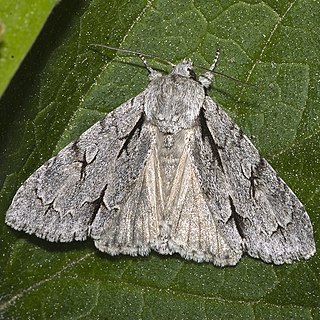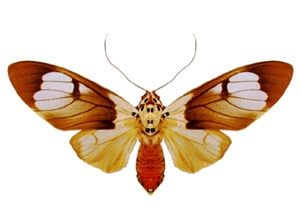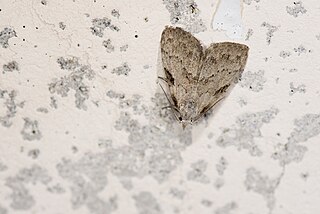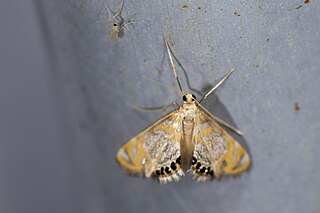
Acronicta is a genus of noctuid moths containing about 150 species distributed mainly in the temperate Holarctic, with some in adjacent subtropical regions. The genus was erected by Carl Linnaeus in his 1758 10th edition of Systema Naturae. Caterpillars of most Acronicta species are unmistakable, with brightly colored hairy spikes, and often feed quite visibly on common foliate trees. The hairy spikes may contain poison, which cause itchy, painful, swollen rash in humans on contact. The larva of the smeared dagger moth is unusually hairy even for this genus. Acronicta species are generally known as dagger moths, as most have one or more black dagger-shaped markings on their forewing uppersides. But some species have a conspicuous dark ring marking instead.

Agrotis is a genus of moths of the family Noctuidae. The genus was erected by Ferdinand Ochsenheimer in 1816. A number of the species of this genus are extinct.

The Pyralinae are the typical subfamily of snout moths and occur essentially worldwide, in some cases aided by involuntary introduction by humans. They are rather rare in the Americas however, and their diversity in the Australian region is also limited. Altogether, this subfamily includes about 900 described species, but new ones continue to be discovered. Like many of their relatives in the superfamily Pyraloidea, the caterpillar larvae of many Pyralinae – and in some cases even the adults – have evolved the ability to use unusual foods for nutrition; a few of these can become harmful to humans as pests of stored goods.

Hypena is a genus of moths in the family Erebidae. It was first described by Franz von Paula Schrank in 1802. These non-migratory moths overwinter as pupae and almost never estivate as adults.

Amerila is a genus of moths in the subfamily Arctiinae.

Cisthene is a genus of lichen moths in the family Erebidae. The genus was erected by Francis Walker in 1854.

Cyana is a genus of moths in the family Erebidae. Species are well distributed in Africa, Madagascar, China, India, Sri Lanka, Myanmar, Sumatra, Java and Borneo. The genus was erected by Francis Walker in 1854.

Estigmene is a genus of tiger moths in the family Erebidae erected by Jacob Hübner in 1820. The species in the genus are native to North and Central America.
Nephelomilta is a monotypic moth genus in the subfamily Arctiinae. Its single species, Nephelomilta suffusa, is found in India's Nilgiri Mountains. Both the genus and species were first described by George Hampson; the genus in 1900 and the species in 1891.
Pareugoa is a monotypic moth genus in the subfamily Arctiinae. Its single species, Pareugoa multistrigata, is found in Assam, India. Both the genus and species were first described by George Hampson, the genus in 1900 and the species two years earlier.
Siccia is a genus of moths in the family Erebidae. The genus was erected by Francis Walker in 1854.

Manoba is a genus of moths in the family Nolidae. The genus was first described by Francis Walker in 1863.
Thermeola is a monotypic moth genus in the subfamily Arctiinae. Its only species, Thermeola tasmanica, is found in the Australian state of Tasmania. The genus and species were described by George Hampson in 1900.

Eoophyla is a genus of moths of the family Crambidae. It was erected by Charles Swinhoe in 1900.

Udea is a genus of snout moths in the subfamily Spilomelinae of the family Crambidae. The genus was erected by Achille Guenée in 1845. The currently known 216 species are present on all continents except Antarctica. About 41 species are native to Hawaii.

Nymphicula is a genus of moths of the family Crambidae.

Pyrausta is a speciose genus of moths of the family Crambidae. The genus was erected by Franz von Paula Schrank in 1802.

Acontia is a genus of moths of the family Noctuidae. The genus was named by Ferdinand Ochsenheimer in 1816. Eusceptis, Pseudalypia and Spragueia are sometimes included in the present genus, but here they are tentatively treated as different pending further research. Many species of Tarache were also once placed here.

Mocis is a genus of moths in the family Erebidae. The genus was erected by Jacob Hübner in 1823.

Aglossa is a genus of small moths belonging to the family Pyralidae. It was described by Pierre André Latreille in 1796. They are found mainly in western Eurasia, though some species have been introduced elsewhere.















